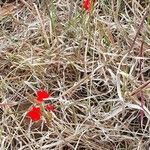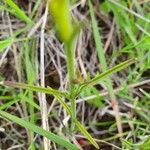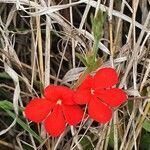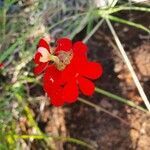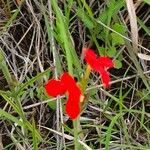Annual herb, parasite, 0.05-0.45 m high; stem erect, branched, scabrid, hispid. Leaves (8-)16 x 1 mm, alternate or opposite, linear, entire, apex obtuse, scabrid. Inflorescence a terminal spike; flowers opposite or alternate. Bracts linear, longer than calyx. Calyx 6 x 2.5 mm, scarious between ribs, scabridly hairy on ribs and teeth. Corolla scarlet internally, yellow externally, glabrous or puberulous; tube bent in upper part near limb; lobes obovate, upper lobe emarginate, lower lobes spreading. Ovary with persistent style; stigma with white pollen. Flowering time Jan., Feb.
Annuals, 10-20(-30) cm tall, entirely hirsute. Stems erect, 1, rarely branched. Leaf blade linear to narrowly lanceolate, 5-20 X 1-4 mm, sometimes reduced to scales. Flowers axillary, solitary or in a spike upward. Calyx 4-8 mm, 10-ribbed; lobes 5, as long as tube, subulate. Corolla usually yellow, rarely red or white; tube 0.8-1.5 cm, apically strongly curved; upper lip 2-lobed. Capsule ovoid, enveloped in persistent calyx. Fl. autumn.
Annual, hemiparasitic herb, up to 0.3 m high; hispidulous-scabrid. Stems harshly pubescent. Leaves with blade linear, ± 20 x 3 mm. Flowers: alternate, 2 or 3 out at a time, in slender spikes; calyx with 10 or more ribs (nerves), at least 1 between each calyx tooth; corolla tube minutely glandular-puberulous outside, upper lip much shorter than lower, red; Dec.-May.
A small herb that grows attached to other plants. It grows 10-15 cm high. It has lines of hairs along it. The leaves are small and narrow or like scales. They are 1 cm long by 1-2 mm wide. The flowers are golden, red or white. They occur singly in the axils of leaves.
Corolla scarlet within, yellowish without, rarely all yellow, 13 mm. long; tube bent in upper part near limb, whole limb positioned at right angles to tube; upper lobe emarginate, 4 mm. wide, lower lobes spreading 4 x 1.5 mm.
Semiparasitic herb, up to 300 mm tall, hispidulous-scabrid. Leaves linear. Spikes very slender. Corolla tube minutely glandular-puberulous outside upper lip much shorter than lower. Flowers red.
Sparsely branched herb, stems 15–20 cm. tall, branching from above the middle, densely hispid, square in cross section.
Flowers opposite or alternate, only 2 flowers open at a time per inflorescence branch.
Bracts 9–12 mm. long, longer than calyx; bracteoles 2 mm. long or less.
Style persistent, usually with white pollen mass on the stigma.
Calyx 6 mm. long, including teeth (teeth 2 mm.), 2.5 mm. wide.
Leaves ascending, 8–16 mm. long, less than 1 mm. wide.
Capsule 7 x 2 mm.
